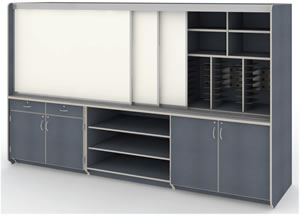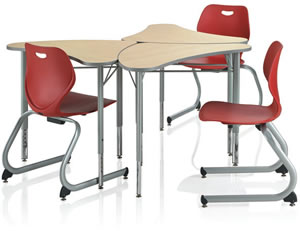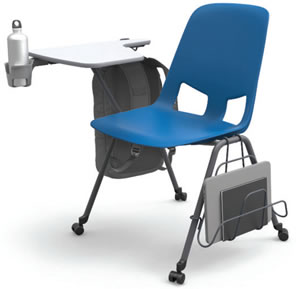Flexibility Is Key

PHOTO COURTESY OF FLEETWOOD GROUP
Today’s active teaching and learning approaches call for furniture versatile enough to work now, tomorrow and down the line. Flexibility, in terms of furniture’s parts, uses, or both, is one of the keys.
The need to choose the right furniture is likely to become even more pressing, given the dynamic scene in classrooms. One reason: more and more K-12 students are experiencing active learning for greater percentages of their academic life, points out Amy Kiefer, vice president, education markets, for KI, and with that experience comes expectations. The idea applies to overall settings as well, and given the range of activities in classes today, “charging stations are the only things that fix a position in a classroom,” Kiefer believes.
If that’s the case, then a large conceptual space, in addition to a physical one, can be opened up. Furniture can reflect and amplify that, and is doing so in a variety of specialized ways.
KI worked, for example, with Pan American Academy Charter School in Philadelphia, where the driving theme of the furniture, according to the company, is that it “works together to create colorful, vibrant, collaborative learning environments.” The furniture includes curving pieces that can stand alone or be pushed together for larger, shared surfaces.

PHOTO COURTESY OF KI
You Gotta Move. Furnishing today’s learning environments is more challenging than in the past. But the upside to that is that designers, teachers and students get to be more creative. Teachers no longer need to stand and lecture, student no longer need to sit in rows and listen, and designers can use their imagination and skills to create furniture and equipment that will work with the new methods.
In another approach, Virco has a line of chairs that combines a handhold and locking casters for swift movement or swivel of the furniture and, once it’s in place for a given lesson, the ability to keep the chair stationary — so restless youngsters can’t roll their chair about — until it’s time to rearrange yet again.
Dynamic individual-to-collaborative and back-again furniture pieces and arrangements take different forms as students progress from kindergarten through 12th grade. For example, Joe A. Agati, president of Agati Furniture, points out that furniture, by being modular and easy to move and reconfigure, can respond to the desire of high schoolers, as well as college students, to work together, whether in or outside a class setting. Accordingly, his company has an upholstered bench system that can either stand alone and thus be open, or be combined to create a secluded collaborative workspace in the round with a center table. In a sense, the configuration creates a temporary workroom within a room.
Working together and the increasing use of tablets and laptops are also generating additional responses. The trends are shrinking individual work surfaces while growing collaborative work surfaces — necessitating smaller individual desks easy to combine into larger work surfaces, notes Jeff Pett, vice president of sales and marketing at Fleetwood Group. He says such working styles are not just happening in the classroom, but also throughout a school, including hallways, for example, which group tables can essentially turn into main streets of ad hoc work. Pett also sees plenty of interest in flip and nest tables, which have table tops that store in a vertical position, saving space and adding to a room’s versatility.

PHOTO COURTESY OF AMERICAN SEATING
And just as active furniture is spreading throughout a school building, flexibility is spreading through types of furniture. It’s not just chairs, tables and desks. Take cabinetry, for example. Pett explains that his company’s casework, which has white boards and storage in various configurations and sits on concealed casters, can be pushed against a wall, perhaps at the front of the class, for a conventional room layout, or can be positioned elsewhere as needed to also serve as a room divider. He adds that the furniture option is generating plenty of interest, including the growing Charleston County School District in South Carolina, which ordered his casework for 15 of its schools.
One supplier, Sauder Manufacturing Co., has seen increased interest in interlocking, modular upholstered furniture for a few years now. According to Sheila Baumgartner, education marketing manager for Sauder Education, high schools are using such pieces for virtual academy lounges. The furniture speaks to a broad trend, she points out: the effort to help high school students to get ahead while saving money down the line in college, by offering in-school space and time as part of the students’ process of testing out of some college courses. In another sense, creating and furnishing lounge environments in high schools is another way to acclimate students to the kinds of settings that many will soon be encountering in higher education. Along that line, versatile furniture helps young people discover how they like to study, she adds.
The effect of flexible furniture is complemented and amplified by other features and products and vice versa, with applications that vary almost as much as curricula. Schools with dance programs, for example, can add options with sprung floor systems that can not only accommodate multiple types of dance performance, but can also be moved to different rooms and buildings as programs change over time. In very different kinds of examples, modular wireway systems mounted on, or in, floors, add flexibility; and overhead and sectional doors, as well as partitions, room dividers and moveable walls define and change space easily to enable multiple uses.
At Woodland Hills High School in Pittsburgh, for example, flexibility was a key to a major remodeling project to its library, which was completed in February 2013. According to School Librarian Kevin McGuire, automatic dividing walls by Moduflex— the system is soundproof and carries dry erase boards — can create as many as four quadrants in the bustling space for simultaneous lessons, presentations and activities.
It’s a telling example as districts look ahead to the kinds of active furniture that will support their larger educational goals. McGuire adds a point about school libraries that is relevant to spaces throughout schools: “Make it able to be used for any changes and to adapt to different learning styles. The space needs to reflect that.”
Furniture that stays useful amid dynamic change is part of the equation.
Tips about active furniture for active teaching and learning:
- Ask good questions. No one can foresee all the changes coming to classrooms within the lifespan of furniture, but talk with others inside and outside your district about what their ideas and choices.
- Keep your curiosity high in terms of how youngsters are using technology and what the experts are doing and watching in terms of that technology, suggests KI’s Amy Kiefer. What kind of furniture could work well with that technology?
- Get involved early in the process of thinking through the best approach, says Jeff Pett of Fleetwood Group, and “don’t build anything in.” In other words, keep things mobile.
This article originally appeared in the issue of .